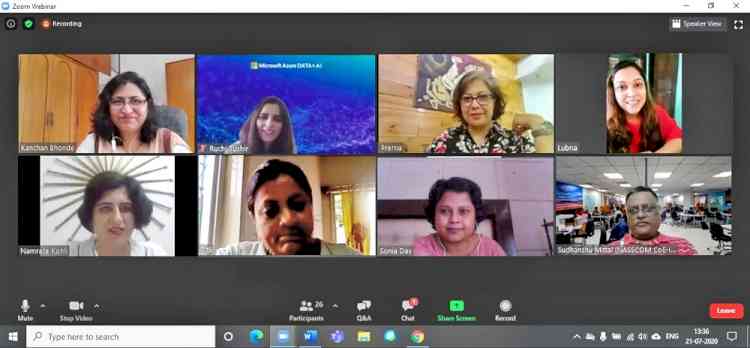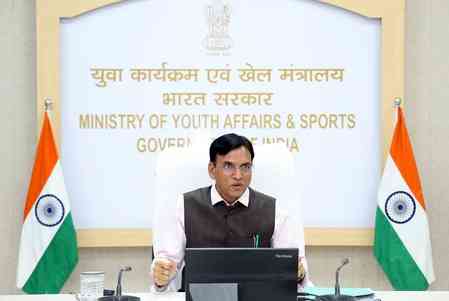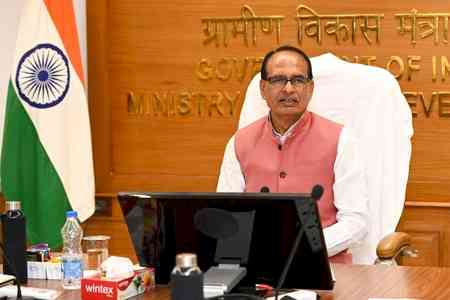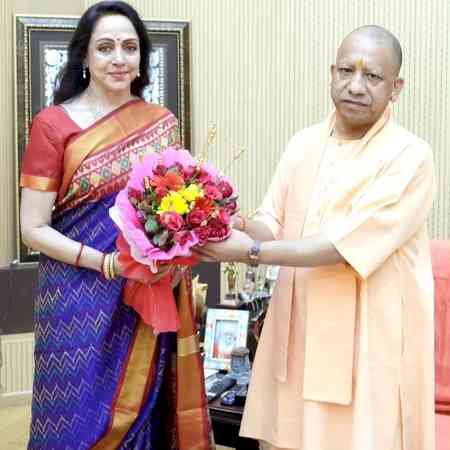Women entrepreneurs and leaders discuss gender related issues at NASSCOM CoE – IOT and AI webinar
A community-building initiative of NASSCOM CoE and moderated by Namrata Kohli (senior journalist, author, and commentator)

New Delhi: NASSCOM Centre of Excellence – IoT & AI organized the webinar ‘Looking at the Pandemic through a Gender lens – How to create a community and drive inclusion’ that saw women entrepreneurs and leaders talked about the challenges in managing work-life balance, and how those have got aggravated post COVID. A community-building initiative of NASSCOM CoE and moderated by Namrata Kohli (senior journalist, author, and commentator), the webinar witnessed women panelists discuss how women can encourage each other, how it is important for the AI-ML developers to work on technologies or apps that can eliminate gender disparities, among other topics.
Women participation in the IT workforce is 34% in India which is highest among all non-agricultural sectors in the country after e-commerce (67.7%) and retail (52%), according to NASSCOM 2018; Raghuram et al 2017. The irony is that over 51% of entry-level recruits are women, over 25% of women are in managerial positions but less than 1% are in top-level/C-Suite. More women are in software testing jobs (34:66 as men-women ratio) which are less sought after than hardcore programming roles (men-women ration as 75:25). Talking on the theme and challenges being faced during Covid, Kanchan Bhonde, Product Strategy Head, Makers Lab, Tech Mahindra, said, “The frustration is the ever-increasing commitments in both office and home work; creating a professional environment in the ambience of home; keeping kids engaged; no domestic help, etc. Looking forward one can say that pandemic is here to stay, so the need is to build alternative ecosystems; work and life beyond work need to be balanced. The value created for the organization is more important than time spent, so add value and articulate it.”
Sq Ldr Prerana Chaturvedi, CEO, Evolet, delved on the challenges being faced by the women and the questions being raised on their effectiveness. She said, “Business does not know who is running it or money does not know who is using it; and the guy who is using that money to empower you to do the business does not look at a man or women, he looks at the capabilities to deliver and the capabilities to be able to run that through. They are looking at pure skill sets and when it comes to skill sets, women have an inherent advantage as they connect easily, they have a sixth sense to take right decisions that are backed by education and experience.”
On how women are coping with changes brought in by the COVID on the personal front and gender bias on the tech front, Lubna Yusuf, Author, Founder La Legal, CEO FishEyeBox, Mentor of Change AIM Niti Aayog, said, “The first programmer was a woman 205 years ago, we are always the creator. By birth, we have this responsibility to keep everything together and especially in times as challenging as a pandemic. In the current Covid situation, women are learning, unlearning, and relearning a lot of things. There are issues and it can be interpreted positively; every struggle defines us. When we talk of gender bias then we have to understand why this bias is created. Women are objectified in the virtual world. The responsibility is with the AI developers to understand that it should be used for social development and not to misuse it.”
Talking on the technologies that are going to help India post COVID, Dr Anupama Mallik, CEO/MD of Vizara Technologies Pvt Ltd that created detailed 3D digital models of Indian heritage sites, said, “Today nobody is going to these heritage places and our solutions are making apps to go on web and experience it. We recently completed digitizing five Indian sites — Taj Mahal in Agra, Kashi Vishwanath temple, Konark Sun Temple in Odisha, Rani Ki Vav (stepwell) in Gujarat and the ruins of Hampi in Karnataka. These models can be produced in the size as required. You miss energy coming from different people in the physical office.”
On the current Chinese ban on apps and how it is going to help Indian companies, Aarti Dhiman, Chief Tech Junkie & Evangelist, Gesture Research International Ltd, said, “Tech with a purpose can sell. In the current crisis we are about social distancing and to help the cause we have touchless technology. We have solutions for healthcare in Gesture Controlled Medical Imaging System. A doctor on an operation table cannot touch the patient, in the current scenario, all medical imaging are hanging in the operation theatre. We are providing all medical imagings on screen and a doctor can look at the images through hand gesture by standing far from the screen.”
On which vertical will see an increase in adoption of IoT and AI in post-Covid Indian market, Ruchi Tushir, Director – Data, Artificial Intelligence (AI) & IoT Business Group, Microsoft, said, “There are opportunities that have come out. The spread of automation happened across sectors from CEO boardrooms to kitchens, from gyms to the Public Sector. Banking and insurance saw a complete halt and automation helped them to service their customers where virtual agents took over human agents to interact with the customers. In Healthcare we were understanding cases that are relevant in the Covid scenario, and leveraging data sets to predict what is going to happen, etc. The way automation came to this country is commendable.”
Throwing light on the role of AI-ML and privacy issues of the citizens, Bhonde said, “Government has been trying to come up with ways of digitizing, a lot of data is generated in India; now we have to make it available to make AI models work properly. Instead of looking at data availability as a barrier we have to look at ways to generate the data for India and make it available. As far as privacy is concerned, we have to make sure that data and privacy laws persist; it is important across the world and everyone is coming up with tools to make it happen. The technology must learn the right things and it has certain limits put in by the people developing it.”


 cityairnews
cityairnews 










